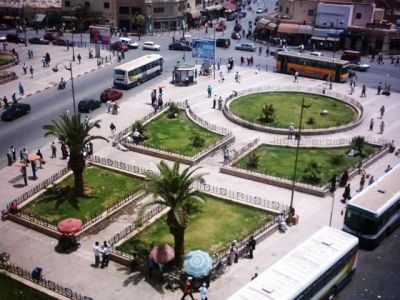




a border town with Algeria OUJDA
Oujda is the capital of eastern Morocco. It is a border town with Algeria.
beautiful mountain regions of Morocco: beni-Isnassen. This ideal location makes it a crossroads between Morocco and other countries of the Maghreb and North Africa on the one hand and between Morocco and Europe via Nador other.Itself is the gateway land of Morocco. It is built on the plain of Angad bordered by one of the most beautiful mountain regions of Morocco: beni-Isnassen. This ideal location makes it a crossroads between Morocco and other countries of the Maghreb and North Africa on the one hand and between Morocco and Europe via Nador other.
Founded in 994 by Ziri Ben Attia chief of the tribe of Maghraoua (nomadic group Zéèntes) Oujda remained the capital of his kingdom for 80 years.
Arab historians report that Ziri Ben Attia wanted to Oujda link removal in case of defeat, saying it was safer in the middle of an empty plain traversed by nomadic or Zenetes to Fez to Tlemcen where the urban population was less attached to him.
Through this city Ziri Ben Attia tried to control a crossroads where CROI caravans from the sea and those joining Sijilmassa Tlemcen in Fez.
Oujda was therefore a node from a major commercial traffic at the intersection of two main axes of movement.
Maghraoua domination that lasted eighty years. Oujda then successively host the Almoravids and the Almohads, who, in 1208, there arose a new belt of fortifications.
Later, Meridians of Fez and Tlemcen Abdelouadites made it an issue that led to its complete destruction in 1271 the king Mérinide Abou Youssef rebuilt the city by building a casbah, a palace, a mosque (Jamaa El Kebir) which still exists today.
Oujda was ruined again between 1335 and 1336 by Sultan Abou Hassan.
After 1336, the city was built gradually in 1679 the Alaouite Sultan Moulay Ismail was partially restore the main buildings of Oujda, which fell shortly after the hands of structures which ended in 1795.
Between 1894 and 1896, an enclosure was built to protect the city that had the shape of an irregular polygon with an area of 28 hectares.
No changes should be made to its appearance until 1907, when the occupation of the city by French troops Oujda March 29.
Three main gates gave access to the town to the east:
Bab Sidi Abdelouahab ogival door flanked by two bastions above Maghzen which was hanging severed heads of rebels hence the name "door top"
North Bab El Khemis. Medina consisted of nine different neighborhoods fractions of the population oujda (achegfane - ahl oujda - oulad amrane - ahl el jamel - oulad el gadi - oulad Aissa - the Mellah)
Medina also included the market area (merchant and raking) and the district of the Kasbah (maghzen offices)
Near the Bab Sidi Abdelouahab a souk MMOU market held every Thursday, five hotels fondouk or three mosques Djamaâ El Kebir, Djamaâ Heddada, Djamaa Sidi Uqba) a madrasa or college, three synagogues.
In the gardens, irrigated by seguia, fed by sources Benyounes Sidi Yahia, people were Oujda vegetable crops.
For safety reasons, the French military camp settled on a hill (572m), which at 900 meters south dominated the medina.
1920 construction of common interest appear:
A covered market place of Arab Bab Sidi Abdelouahab
slaughterhouse near the Kasba
Treasury building
the Court of First Instance
high school boys and old college girls.
In 1910 the standard gauge railway was extended from Algeria to Marnia Oujda.
For technical reasons, the station was built three miles north of the medina. (Village koulouche) 1920, appeared constructions of common interest: a covered market place abdelouahab Arab, a slaughterhouse near the Kasbah Treasury building, the court of first instance, the school boy and the old college girls.
The construction of a new station, decided in 1928, due to the remoteness of the station early, helped prevent any extension to the west of the city is stopped by the garden can only grow by a north-south direction.
Indeed, the constraints of topography imposed the location of the station on the right bank of Oued-Nachef.